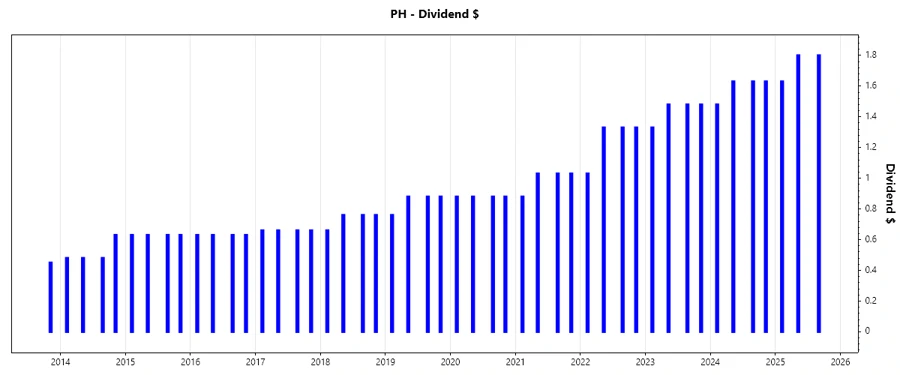October 12, 2025 a 07:46 am




PH: Dividend Analysis - Parker-Hannifin Corporation

Parker-Hannifin Corporation has a strong dividend profile with a 41-year history of payouts, indicating stability and reliability. Coupled with moderate growth and impressive retention rates, the company remains a solid choice for dividend-focused investors.
📊 Overview
Parker-Hannifin Corporation, a leading player in the industrial sector, showcases a commendable dividend yield and persistent dividend history.
| Metric | Value |
|---|---|
| Sector | Industrial |
| Dividend yield | 0.91 % |
| Current dividend per share | 6.71 USD |
| Dividend history | 41 years |
| Last cut or suspension | None |
📈 Dividend History
Parker-Hannifin’s stable dividend history offers a promising track record of payments, crucial for evaluating the consistency and predictability of future cash flows.

| Year | Dividend per Share |
|---|---|
| 2025 | 5.23 USD |
| 2024 | 6.37 USD |
| 2023 | 5.77 USD |
| 2022 | 5.02 USD |
| 2021 | 3.97 USD |
📈 Dividend Growth
The growth in dividends over recent years highlights Parker-Hannifin’s commitment to rewarding its shareholders, an indicator of management’s confidence in the business prospects.
| Time | Growth |
|---|---|
| 3 years | 17.07 % |
| 5 years | 13.37 % |
The average dividend growth is 13.37% over 5 years. This shows moderate but steady dividend growth.

🗣️ Payout Ratio
Payout ratios are critical in assessing dividend sustainability. Parker-Hannifin maintains disciplined payout ratios, underscoring a balanced approach to dividend payments.
| Key Figure | Ratio |
|---|---|
| EPS-based | 24.18 % |
| Free cash flow-based | 25.77 % |
With a low payout ratio of 24.18% (EPS) and 25.77% (FCF), the dividends appear well-covered, ensuring safety and potential for reinvestment into the business.
💰 Cashflow & Capital Efficiency
Understanding the cash flow and capital efficiency provides insights into the company’s operational strengths and its ability to sustain dividends. Parker-Hannifin shows commendable metrics, indicating robust financial health.
| Year | 2025 | 2024 | 2023 |
|---|---|---|---|
| Free Cash Flow Yield | 3.73% | 4.64% | 5.19% |
| Earnings Yield | 3.94% | 4.42% | 4.16% |
| CAPEX to Operating Cash Flow | 11.52% | 11.82% | 12.77% |
| Stock-based Compensation to Revenue | 0.80% | 0.78% | 0.75% |
| Free Cash Flow / Operating Cash Flow Ratio | 88.48% | 88.18% | 87.22% |
Parker-Hannifin’s cash flows demonstrate strength and capital efficiency, supporting future growth and dividend distributions effectively.
🏦 Balance Sheet & Leverage Analysis
Analyzing the balance sheet and leverage ratios gives a sense of the company's financial stability and solvency. Parker-Hannifin maintains healthy leverage levels, reflecting a solid financial structure.
| Year | 2025 | 2024 | 2023 |
|---|---|---|---|
| Debt-to-Equity | 0.69 | 0.87 | 1.22 |
| Debt-to-Assets | 0.32 | 0.36 | 0.42 |
| Debt-to-Capital | 0.41 | 0.47 | 0.55 |
| Net Debt to EBITDA | 1.66 | 2.02 | 2.97 |
| Current Ratio | 1.19 | 0.93 | 0.88 |
| Quick Ratio | 0.71 | 0.55 | 0.51 |
Leverage measures are kept within acceptable ranges, illustrating an effective capital management strategy that secures long-term financial resilience.
📉 Fundamental Strength & Profitability
Profitability metrics and margins underline Parker-Hannifin's operational proficiency, with steady returns and robust margin performance throughout recent years.
| Year | 2025 | 2024 | 2023 |
|---|---|---|---|
| Return on Equity | 25.81% | 23.56% | 20.17% |
| Return on Assets | 11.97% | 9.71% | 6.95% |
| Net Margin | 17.79% | 14.27% | 10.93% |
| EBIT Margin | 22.75% | 20.58% | 17.06% |
| Gross Margin | 36.85% | 35.91% | 33.88% |
| Research & Development to Revenue | 0% | 1.27% | 1.35% |
Profitability remains robust, suggesting continued efficiency in operations and strategic repositioning within the market landscape.
📉 Price Development

✅ Dividend Scoring System
| Criteria | Score | Score Bar |
|---|---|---|
| Dividend yield | 4 | |
| Dividend Stability | 5 | |
| Dividend Growth | 4 | |
| Payout Ratio | 5 | |
| Financial Stability | 4 | |
| Dividend Continuity | 5 | |
| Cashflow Coverage | 4 | |
| Balance Sheet Quality | 4 |
Overall Score: 35/40
💡 Rating
Parker-Hannifin Corporation is a robust contender for dividend portfolios, given its strong historical performance, prudent financial management, and commitment to shareholder returns. With steady growth potential and efficient capital utilization, it remains a favored choice for growth-oriented investors seeking reliable dividends.
